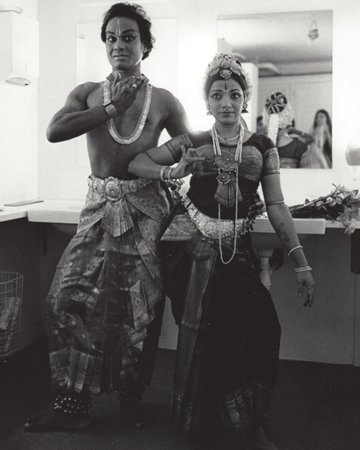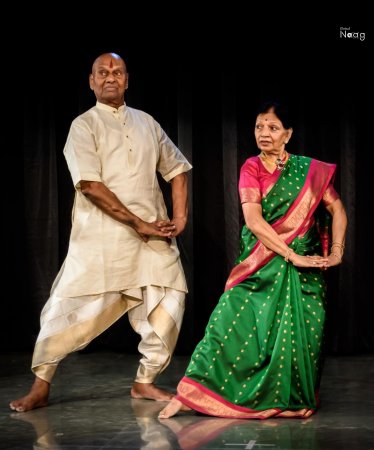
|
 |

|
 |
Raja Reddy: We merge originality with traditional forms - Tapati Chowdhurie e-mail: tapatichow@yahoo.co.in December 8, 2023 The name of Raja-Radha Reddy is synonymous with Kuchipudi dance. Their illustrious career spanning over more than half a century has created a bench mark, which is hard to achieve. Their performances, public or private, in the country or outside have gained them a reputation for rare excellence and technical perfection. Both Raja and Radha Reddy got the Padma Shri and the Padma Bhushan individually and simultaneously for the same cause of propagating Kuchipudi dance. That created history. Similarly they were decorated with the Sangeet Natak Akademi Award too. Sitting in the well-equipped library of his dance institution Natya Tarangini - running for the last 47 years - in Pushp Vihar in New Delhi, this writer had the rare opportunity of interviewing Raja Reddy, the doyen of Kuchipudi dance. Here is an excerpt:  What is the truth of the statement "The history of Kuchipudi dance is intertwined with your name?" Kuchipudi dance is an ancient dance-drama tradition of Andhra known as Yakshagana. The 17th century Kuchipudi dance style of Yakshagana was conceived by Siddhendra Yogi, a Vaishnava poet and visionary. Kuchipudi as a classical dance form came to be recognized in 1959, but the dance form was not very popular. When Radha and I performed in a full length Kuchipudi recital in Delhi sometime after 1966, few people had seen or heard about the form. Perhaps that is the prime reason why our name came to be associated with Kuchipudi dance. It was an arduous task to keep going. As per the words of Swami Vivekananda, "Struggle was our motto". The audience accepted us wholeheartedly; presently the audiences enjoy and love watching Kuchipudi. Dr. Reddy, what have you to say about Dr. Radha who is your partner in life and on stage? Ours was a childhood marriage - when I was 11 years old and Radha was 5. When I got married to her, I virtually got married to dance. With Lord Venkateshwaras's grace, we became not only soul mates but also dance partners for life. What is your story? I was fond of seeing traditional dance dramas presented by travelling Bhagavata Natakam groups who came to our village. When these drama groups travelled to other adjacent villages, I went there under some pretext and used to take part in the small roles of Abhimanyu or Prahlada, unknown to my parents. Someone known to my father had seen me perform. When my father saw me perform in Dilwapuram close to my home in Narasapuram, he did not spare the rod to check his errant son. Without much further delay, he packed me off to Nirmal Taluka to continue my studies. There I had the chance to see the block-buster film Nagin starring Vyjayantimala and Pradeep Kumar with my friends. I was bowled over. I kept copying the dances I had seen in it. After my Matriculation exam I approached Kuchipudi Guru Vedantam Jagannath Sarma to teach me. He insulted me badly and said that my blunt features and complexion were not suitable for any kind of dance, leave alone enacting female roles - those days male dancers used to dance female roles. In no uncertain terms he asked me to till the soil, because that was the only job that befitted me. I was so crestfallen and had practically stopped eating. My friends took me to Hyderabad Music College where Kuchipudi was not taught and Bharatanatyam was taught to women only. The only option I had was to enroll for Kathak. So I had to learn Kathak for two or three years under Ramkrishna Shukla, a disciple of Shambhu Maharaj. But I must confess that learning Kathak gave me a firm grip over rhythm. Meanwhile Radha used to practise with her friends what she saw in Bhagavatam and of course she kept copying whatever I danced. Vedantam Prahlada Sharma had come from Kuchipudi village to Hyderabad with his troupe for a performance. Both Radha and I went to him and he agreed to teach us. The Guru lived in Eluru in Andhra Pradesh. He arranged a room for Radha and me at Eluru, so that we could stay there and learn from him. We learnt Kuchipudi under him for four years and started giving small performances. With meagre finances we managed.  What is the Kuchipudi dance style all about? Kuchipudi is an imaginatively conceived dance style capable of expressing all human emotions with rhythmical body movements and is most suitable for story-telling dramatically, following the rules of dramaturgy. It is redolent with soft movements as well as vigorous movements. It is a classical dance form because of its stylized movements. It is a complete dance drama much like Kathakali of Kerala. All the four different styles of Natya or stylized acting, the graceful, the energetic, the grand, and the verbal are there in Kuchipudi dance. The inclusion of drama in a classical dance form gives Kuchipudi dance its uniqueness. The 21st century is the Digital Age, where a lot of things have become obsolete. Cyber culture is the order of the day. It is a transformed society we are now living in. Under the circumstances is the young generation attracted to pursuing a career in Kuchipudi dance? Classical Indian dance forms, which include Kuchipudi dance have faced challenges and overcome them. Dance is visual poetry and is for all times. In spite of the advancements in technology, their value will not diminish and there will always be takers. However, classical artistes undergo funding crunch. They have problems in getting recognition. In the modern age they have the option of going online. The social media is in a way helpful, because they can at least get seen with no cost involved. However there are other obstacles too, which is the very nature of the art form. Dance has always attracted the passionate and they continue to do so even today. Difficult choreographic work along with music elevates audience experience. The kind of exposure that we give to our disciples contains a lot of modernity which has been adapted without giving up our roots. We merge originality with traditional forms that brings freshness to our choreographic work.  You are a much travelled couple along with Kaushalya Reddy and have performed in all continents. What has been the response of your foreign audiences? We were the first couple to perform a full-length recital of Kuchipudi dance in Delhi. The event was reported by National newspapers as "Andhra dancers storm Delhi." That was a turning point in our dance career. The then Minister of Tourism, Dr. Karan Singh, had seen one of our recitals and had arranged for a programme at Ashoka Convention Hall. The then Prime Minister of India loved our dance immensely. Soon after the Delhi show we visited France and performed at Avignon International Dance Festival there, where our dance was received well. Our ground-breaking milestone was our performance for The Rockefeller Foundation, New York, followed by Queen Elizabeth Hall in London where I was called the Black Shiva. In 1982, the Reddys performed at the Non-Aligned Meet at Delhi for 110 heads of state from across the world. Fidel Castro of Cuba invited us in 1983 to perform before him. I have been performing in foreign shores for more than four decades now. Foreigners have appreciated our performances for their aesthetic beauty. Everything about Indian culture starting from its mythological stories, stories from the epics, the treatise Natya Sastra, the dance music and musical instruments, our jewellery, our clothes and our colourful presentations awaken their curiosity. They are a highly receptive and appreciative audience. How do you disseminate knowledge and practice of Kuchipudi dance? We – Radha, Kaushalya and I- have set up an institute for dance, the Natya Tarangini Performing Arts Centre, which is imparting knowledge to more and more students. The uniqueness of this institute is that we teach our students ourselves, which results in personal care and adds quality to what they learn. What is special about your Parampara series? To redefine and rejuvenate India's rich cultural heritage we organize a National Festival of Dance and Music named Parampara Series annually where we have provided a platform to named and famed artistes. Besides famous performers from our country, international stalwarts like USA's prime dance company of Paul Taylor, legendary Jose Porcel of Spain, Whirling Dervishes of Turkey and Moscow Classical Ballet have also performed in the Parampara Series. Parampara Series is practically a movement to preserve and enrich the cultural mosaic of our everyday life.  Tapati Chowdhurie trained under Guru Gopinath in Madras and was briefly with International Centre for Kathakali in New Delhi. Presently, she is a freelance writer on the performing arts. Post your comments Please provide your name and email id when you use the Anonymous / blog profiles to post a comment. All appropriate comments posted with name and email id in the blog will be featured in the site. |